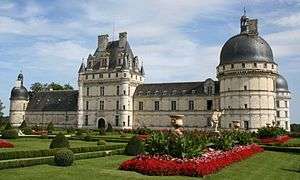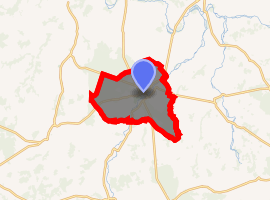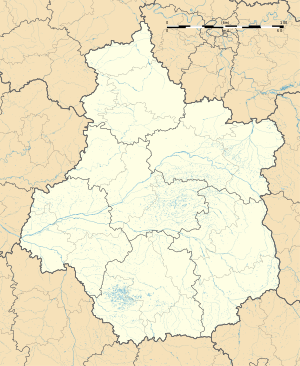Valençay
Valençay is a commune in the Indre department in central France.
Valençay | |
|---|---|
 Château de Valençay | |
.svg.png) Coat of arms | |
Location of Valençay 
| |
 Valençay  Valençay | |
| Coordinates: 47°09′41″N 1°34′01″E | |
| Country | France |
| Region | Centre-Val de Loire |
| Department | Indre |
| Arrondissement | Châteauroux |
| Canton | Valençay |
| Intercommunality | Valençay |
| Government | |
| • Mayor (2008–2014) | Claude Doucet |
| Area 1 | 41.59 km2 (16.06 sq mi) |
| Population (2017-01-01)[1] | 2,367 |
| • Density | 57/km2 (150/sq mi) |
| Time zone | UTC+01:00 (CET) |
| • Summer (DST) | UTC+02:00 (CEST) |
| INSEE/Postal code | 36228 /36600 |
| Elevation | 91–154 m (299–505 ft) (avg. 145 m or 476 ft) |
| 1 French Land Register data, which excludes lakes, ponds, glaciers > 1 km2 (0.386 sq mi or 247 acres) and river estuaries. | |
Geography
Valençay is situated in the Loire Valley on a hillside overlooking the River Nahon.
History
The commune was formed by the amalgamation of three settlements: the "Bourg-de-l'Eglise", the "Bas-Bourg" and what is called the "old quarter."
Valençay is part of Berry by virtue of its geographical situation. However, the chateau is a part of the Loire Valley by virtue of the date of its construction and its vast dimensions, which give it a similar appearance to Chambord. Built at the end of a plateau, it faces the river Nahon. The entrance astonishes by its dissymmetry and the surprising presence of an enormous tower and a house. The wing offers a more homogeneous style but this unity is only on the surface and disguises several rebuildings. The chateau was in the 16th and 17th centuries by the family of Estampes. The castle of 12th century which existed on this site, was demolished and construction of its replacement began in 1520, albeit very slowly.. Louis of Estampes, governor and baillif of Blois, undertook the building of the large round tower at the end of the entrance wing. He died in 1530, leaving the tower unfinished.
A castle of financial. Work on Valençay began again about 1540 thanks to Jacques of Estampes, lord of the manor of the feudal residence which existed at this place. This lord, having married the girl grassement equipped with a financier, wanted to have a residence worthy of his new fortune. Jacques of Estampes makes cover the tower of a dome to imperial. Starting from the tower, it raises half of the wing in return and begins the wing of entry. At the 16th century end. Jean of Estampes builds surprising it house of entry in the shape of keep, confined of four turrets and crowned of a covered way, like the tower. He connects it by a body of gallery on a floor to the first spans built by Jacques. Jean of Estampes builds also the building and the tower on the left of the central house. At the 17th century, Dominique of Estampes finished the wing in return in the same style as the first half high to 16th century. One knows by an old sight that the castle then had the form of a quadrilateral closed by a second wing in return and, at the bottom of the court, by arcades. Finance remains often mixed with the history of Valençay: among its successive owners pass from the general farmers. Thus Valençay is sold in 1747 and is acquired little afterwards by the general farmer Legendre de Villemorien. This one made cut down a part of the buildings, preserving only the wing of entry and the first wing in return of which it transforms the roof and at the end of which it raises a tower. The famous John Law of which dazing it adventure was a first and masterly example of inflation was himself also one of the owners of the castle.
On 6 May 1941, Georges Bégué, the first SOE agent from England, was parachuted into a field near Valençay. Fifty years later to the day, the Valençay SOE Memorial, originally known as the "Spirit of Partnership," was dedicated in honour of the 104 members of SOE's F Section who died for the liberation of France.
Population
| Year | Pop. | ±% |
|---|---|---|
| 1793 | 2,299 | — |
| 1800 | 2,300 | +0.0% |
| 1806 | 2,519 | +9.5% |
| 1821 | 2,712 | +7.7% |
| 1831 | 3,095 | +14.1% |
| 1836 | 3,289 | +6.3% |
| 1841 | 3,229 | −1.8% |
| 1846 | 3,425 | +6.1% |
| 1851 | 3,627 | +5.9% |
| 1856 | 3,476 | −4.2% |
| 1861 | 3,587 | +3.2% |
| 1866 | 3,653 | +1.8% |
| 1872 | 3,547 | −2.9% |
| 1876 | 3,517 | −0.8% |
| 1881 | 3,554 | +1.1% |
| 1886 | 3,547 | −0.2% |
| 1891 | 3,621 | +2.1% |
| 1896 | 3,431 | −5.2% |
| 1901 | 3,346 | −2.5% |
| 1906 | 3,411 | +1.9% |
| 1911 | 3,343 | −2.0% |
| 1921 | 2,976 | −11.0% |
| 1926 | 2,874 | −3.4% |
| 1931 | 2,789 | −3.0% |
| 1936 | 2,762 | −1.0% |
| 1946 | 2,739 | −0.8% |
| 1954 | 2,679 | −2.2% |
| 1962 | 2,732 | +2.0% |
| 1968 | 2,754 | +0.8% |
| 1975 | 2,952 | +7.2% |
| 1982 | 2,947 | −0.2% |
| 1990 | 2,912 | −1.2% |
| 1999 | 2,736 | −6.0% |
| 2006 | 2,641 | −3.5% |
| 2009 | 2,617 | −0.9% |
Sights
The town is dominated by the Château de Valençay, built in 1540 by Robert d'Estampes and most notably acquired in 1747 by the Scottish Banker John Law. In 1803 the castle was purchased by the diplomat Charles Maurice de Talleyrand.
Economy
The town is known for its pyramid-shaped Valençay cheese made from raw goats' milk.
See also
- Berry
- Saint-Benoît-du-Sault
- French wine
- Communes of the Indre department
- Pearl Witherington, Resistance leader during World War II
External links
| Wikimedia Commons has media related to Valençay. |
- Official website of Valençay
- Official website of Valençay's Castle
- www.vins-fromages-valencay.com - Valençay wines and cheeses